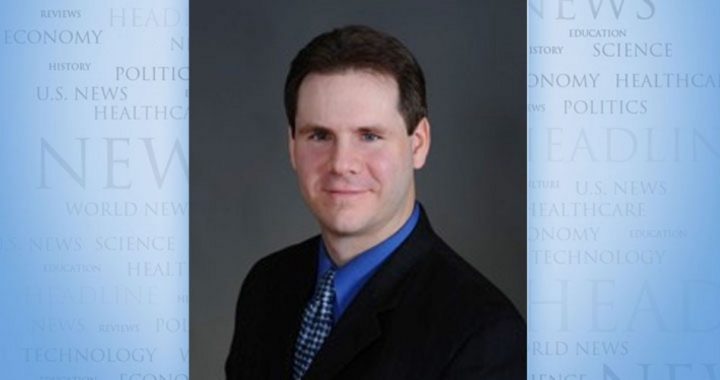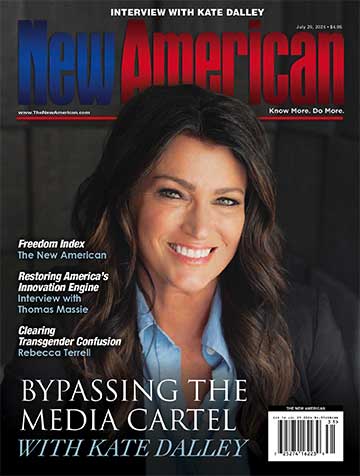
“When people cease believing in God, it’s not that they start to believe in nothing; it’s that they’ll believe in anything,” goes a common encapsulation of G.K. Chesterton’s ideas. This could come to mind, and did, when pondering a question commentator Daniel Greenfield recently asked. To wit:
“How do you create a generation that will believe in anything?”
The point of Greenfield’s piece is, essentially, that we have cultural mutants among us who are ever mutating further. In particular, “After Oct 7, some purple-haired genderqueer activists on TikTok have taken to reading the Koran and are pondering converting to Islam,” the writer relates. “That may seem like a leap, but once you’re a teenage girl who decides to be a boy for internet clout, changing to Islam is less difficult.” No question.
(It also provides something sexual devolutionary agendas don’t: Firm structure, guide rails for living life.)
“Hijabs, like dyed hair and androgynous clothes, have long become just another accessory of restless social change,” Greenfield continues. “Commercials that claim to relate to the youth invariably include a woman in a hijab as a progressive marker alongside a purple haired they/them, an ascetic activist type in a t-shirt and random minorities laughing together while having lattes on a college campus.”
The writer then states, “Every generation in the last 60 years has grown up with less of a sense of who it is than the previous one.” Absolutely true. Yet one could wonder about the qualities Greenfield cites as having once defined “American identity,” as he mentions “boundless frontiers, a work ethic, a sense of fair play and meritocracy” and… — that’s it. These are good things, of course; the latter three reflect virtues, in fact. Yet Greenfield’s list seems like a dodge.
After all, if a people in the Far East speaking a language alien to us enjoyed “boundless frontiers, a work ethic, a sense of fair play and meritocracy,” would they be American?
A better way of framing American identity (or any national identity) would start with commentator Michael Savage’s famous “borders, language, culture” line — but wouldn’t end there. We should add: history, sense of virtue (hopefully the correct one!), and, ideally, faith. Consanguinity matters, too. The more of these elements people share, the more they are one people, one national family.
In light of the above, it’s obvious where we are now. While Americans enjoyed consanguinity (having the same remote ancestors) only during our civilization’s nascent stages, the profound differences between the many peoples who’d come to our shores had noticeably diminished by the 1960s. The descendants of the Germans, Italians, Irish, and others spoke the same language, English, with the same accents; largely wore the same clothing; imbibed the same entertainment; and ate the same foods (processed and artery clogging though they often were).
These peoples were generally Christian, too, and though sectarian/doctrinal differences are not irrelevant, the West’s secularization (which is problematic itself) made them less prominent. The bottom line is that by the ’60s, these peoples were becoming “a people,” embracing the same culture and history and sense of virtue. All these varied ethnicities were gradually transitioning into a new common ethnicity: “American.”
For example, in elementary school even in liberal New York City in the 1970s, the Founding Fathers and Christopher Columbus were portrayed as heroes to us children, and we all considered them admirable. Today, of course, they’re under withering assault, demeaned and demonized.
We also had more of a shared sense of virtue, with a common understanding of marriage, the sexes, sexuality (once we learned about it; though post-Sexual Devolution, this sense was already being distorted), and many other things. No, we weren’t monolithic, but we were largely united. And now? We’re not divided.
We’re fractured.
Kids today don’t grow up with a sense of being “American” — they don’t have this identity — because there’s little agreement on what being American means. So, of course, they find their “identity” elsewhere.
Greenfield does a good job outlining what has caused this fracturing and where youths find their identities, fingering the culture shapers in entertainment, media, and academia, and on the internet.
“Social media combined with academic theories that reduced all identities to a construct unleashed a generation of mutants who mimeographed behaviors on social media,” Greenfield writes. “Identity became a game” — that could be leveraged for personal advantage.
“Politics became just another cultural identity that could be cosplayed at will,” Greenfield later added. “Some social media influencers played far-leftists and then fascists [is there a difference?], putting on and taking off costumes, swapping t-shirts with different slogans, Antifa shirts giving way to farm dresses and then hijabs.” He is correct, too: These twisted, damaged people don’t have principles, but provisional preferences. Why, however, is interesting.
Preferences are all moderns usually have because, under their essentially godless, relativistic world view, preference is all that can exist. True principles derive from Truth, which is objective, unchanging, eternal. When a Christian chose to go to the lions in the Roman arena rather than renounce his faith, he didn’t do it because his doctrines were a flavor of the day that “worked for him”; he believed he was abiding by divine enjoinment. Could you imagine someone choosing execution rather than relinquish his “gender” identity?
To use my oft-mentioned diet analogy, a person who believes in and grasps human nutrition’s laws can’t be easily swayed into swallowing poison with the appeal, “If it tastes good, eat it!” But someone who fell victim to “dietary relativism” and thus didn’t believe in those laws — and hence supposed that no substance could be inherently good or bad — would only have one yardstick left for determining what to ingest: taste. And just as the dietary relativist lacks the guide rails of nutritional laws to direct him toward physical health, so does the moral relativist lack the guide rails of moral laws to direct him toward spiritual/psychological health.
So what’s occurring is not surprising. Being devoid of moral principle and lacking in virtue — but still being social creatures as humans will be — modern young are seduced by fads and cannot resist social pressure (on social media and elsewhere). They want to belong, but have nothing to tell them that what they must drink for group initiation is moral poison.
But “man does not live on bread alone” — or on cultural junk food alone. And, ironically, this gives Islam an opening. It does provide that aforementioned set of unbending guide rails, which these confused youth on some level may crave. And that’s where the radical “preferences” may end and the radical piety begin.
It has happened before. Then-young John Walker Lindh, from very liberal Marin County, California, converted to Islam at 16 — and became the infamous “American Taliban” three years later.
The moral of this story is that even shape-shifting relativists often have, eventually, a final mutation.



